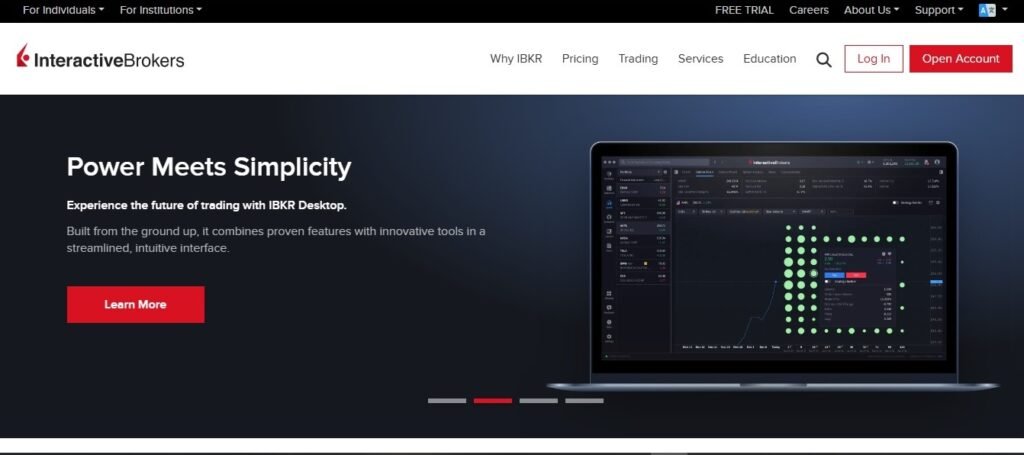
Did you know that over 50% of Americans invest in the stock market. But, If you’re a beginner, then you could be wondering where to begin. The good news: the process doesn’t have to be stressful! This guide will walk you through the entire process—step by step—on how you can buy your first stock with confidence.
Whether you’re looking to grow your wealth, beat inflation, or just dip your toes into the world of investing, you’ll find everything you need here.
Let’s get started!
Table of Contents
Step 1: Understand the Basics of Stock Investing
What is a Stock?
A stock represents a share of ownership in a company. When you buy a stock, you become a partial owner of that company. If the company does well, the value of your stock goes up; if it struggles, the value may drop.

Why Invest in Stocks?
- Wealth Growth: Historically, stocks offer higher returns than savings accounts or bonds.
- Beating Inflation: Stock investments help your money maintain its purchasing power over time.
- Dividend Income: Some stocks pay dividends, which are regular payments to shareholders.
Step 2: Set Your Investment Goals
Before you invest, ask yourself: Why am I investing?
- Are you investing for long-term growth (e.g., retirement)?
- Do you want short-term gains (e.g., swing trading)?
- How much risk can you handle?
Beginner Investing Tips:
✅ Start small – even $50 can get you started.
✅ Be patient – stocks fluctuate; think long-term.
✅ Diversify – don’t put all your money into one stock.
Step 3: Choose the Right Brokerage Account
A brokerage account is like a bank account that lets you buy and sell stocks. However, not all brokerage accounts are the same—some are better suited for beginners, while others cater to advanced investors.
Choosing the right brokerage is a crucial step in your investing journey. A good brokerage should offer low fees, an easy-to-use platform, and strong educational resources to help you make informed decisions.
How to Choose a Brokerage Account
When selecting a brokerage, consider the following factors:
✅ Low Fees: Look for commission-free stock trading or platforms with low trading fees. Avoid brokers with high commissions, maintenance fees, or hidden costs.
✅ User-Friendly Interface: If you’re a beginner, choose a platform with an intuitive dashboard and mobile-friendly app.
✅ Educational Resources: Some brokerages offer beginner-friendly tutorials, webinars, and market analysis tools.
✅ Investment Options: Ensure the brokerage allows you to invest in stocks, ETFs, mutual funds, and fractional shares if you want to start small.
✅ Customer Support: Having access to reliable customer service via chat, email, or phone is essential if you need help.
✅ Geographical Availability: Some brokerages are only available in specific countries. Make sure the platform operates in your region.
Below is a list of some of the best online brokerages for beginners, along with their features, pricing, and geographical availability.
1. Robinhood 🏆
📍 Available in: United States
💰 Pricing:
- Commission-free trading for stocks, ETFs, and options
- No account minimum
- Robinhood Gold: $5/month (for research tools & margin investing)
🔹 Why It’s Good for Beginners:
- Super easy-to-use mobile app
- No trading fees, making it great for small investors
- Fractional share investing
🛑 Downside: Lacks advanced research tools and customer support can be slow.
2. Fidelity 🔍
📍 Available in: United States
💰 Pricing:
- Commission-free trading on stocks & ETFs
- No account fees or minimum balance
- Fractional shares available
🔹 Why It’s Good for Beginners:
- Excellent research tools and educational resources
- No hidden fees or account maintenance charges
- Strong customer support
🛑 Downside: The platform may feel overwhelming due to its many features.
3. E*TRADE 📚
📍 Available in: United States
💰 Pricing:
- $0 commission for online stock & ETF trades
- $0 minimum deposit
- Options contracts: $0.65 per contract
🔹 Why It’s Good for Beginners:
- Top-tier educational resources (video tutorials, webinars, and articles)
- Easy-to-use platform with a great mobile app
- Paper trading feature to practice investing without real money
🛑 Downside: Higher options contract fees compared to competitors.
4. Charles Schwab 💼
📍 Available in: United States, United Kingdom, Hong Kong
💰 Pricing:
- $0 commission on stocks, ETFs, and options
- No account minimums
- Fractional shares available
🔹 Why It’s Good for Beginners:
- Schwab Starter Kit offers new investors $50 in free stock
- Top-rated research and investment guidance
- Access to 24/7 customer support
🛑 Downside: Not the best mobile app experience for active traders.
5. Webull 📈
📍 Available in: United States, Hong Kong, Singapore
💰 Pricing:
- Commission-free stock & ETF trading
- No account minimum
- Crypto trading available
🔹 Why It’s Good for Beginners:
- Advanced charting and analytics tools for free
- Great mobile app for active traders
- Paper trading feature for practice
🛑 Downside: Lacks strong educational resources for beginners.
6. TD Ameritrade 📊
📍 Available in: United States
💰 Pricing:
- $0 commissions on stocks & ETFs
- No account fees
- Free access to thinkorswim trading platform
🔹 Why It’s Good for Beginners:
- Industry-leading educational resources (webinars, courses, tutorials)
- Paper trading to test strategies before investing real money
- Great customer support
🛑 Downside: Some features may feel too advanced for complete beginners.
7. SoFi Invest 🌱
📍 Available in: United States
💰 Pricing:
- No commissions on stock & ETF trades
- No account minimum
- Fractional shares available
🔹 Why It’s Good for Beginners:
- Automated investing option for hands-off investing
- Access to financial advisors for free
- Good for long-term investors
🛑 Downside: Lacks advanced trading features for active traders.
8. Interactive Brokers (IBKR) 🌍

📍 Available in: Over 200 countries (including US, UK, Europe, Asia)
💰 Pricing:
- IBKR Lite: $0 commission on US stocks & ETFs
- IBKR Pro: Low-cost trading for advanced investors
🔹 Why It’s Good for Beginners:
- Global access to 150+ markets
- Comprehensive research tools
- Low fees for international trading
🛑 Downside: The platform is complex and better suited for advanced investors.
Open an account at Interactive Brokers today
9. M1 Finance 🤖
📍 Available in: United States
💰 Pricing:
- Commission-free investing
- $100 minimum deposit to start investing
- M1 Plus: $125/year (extra benefits like early trading window)
🔹 Why It’s Good for Beginners:
- Automated investing with “Pie” strategy (great for passive investors)
- Fractional shares available
- No trading fees
🛑 Downside: No real-time trading—orders are only placed once per day.
10. Degiro 🇪🇺
📍 Available in: Most European countries
💰 Pricing:
- Low-cost stock trading (varies by region)
- No inactivity fees
- Low-cost ETF investing
🔹 Why It’s Good for Beginners:
- One of the cheapest brokers in Europe
- Simple, beginner-friendly interface
- Strong regulatory framework
🛑 Downside: No fractional shares available.
Which Brokerage Should You Choose?
If you’re a beginner, here’s a quick guide to help you decide:
- For a simple, commission-free experience: 👉 Robinhood, Webull, SoFi Invest
- For the best educational resources: 👉 TD Ameritrade, E*TRADE, Fidelity
- For international investors: 👉 Interactive Brokers, Degiro
- For automated investing: 👉 M1 Finance, SoFi Invest
- For best research tools: 👉 Charles Schwab, Fidelity, TD Ameritrade
No matter which brokerage you choose, the key is to start small, learn as you go, and stay consistent. Happy investing! 🚀
Would you like recommendations based on your country or investment style?
Here’s a comparison of fees and commissions for the top beginner-friendly brokerages:
| Brokerage | Stock & ETF Trading | Options Trading | Fractional Shares | Account Fees | Minimum Deposit | Geographical Availability |
|---|---|---|---|---|---|---|
| Robinhood | $0 | $0.65 per contract (only for certain options) | ✅ Yes | None | $0 | 🇺🇸 US only |
| Fidelity | $0 | $0.65 per contract | ✅ Yes | None | $0 | 🇺🇸 US only |
| E*TRADE | $0 | $0.65 per contract | ❌ No | None | $0 | 🇺🇸 US only |
| Charles Schwab | $0 | $0.65 per contract | ✅ Yes | None | $0 | 🇺🇸 US, 🇬🇧 UK, 🇭🇰 Hong Kong |
| Webull | $0 | $0.55-$0.65 per contract | ✅ Yes | None | $0 | 🇺🇸 US, 🇭🇰 Hong Kong, 🇸🇬 Singapore |
| TD Ameritrade | $0 | $0.65 per contract | ❌ No | None | $0 | 🇺🇸 US only |
| SoFi Invest | $0 | Not available | ✅ Yes | None | $0 | 🇺🇸 US only |
| Interactive Brokers (IBKR Lite) | $0 (US Stocks & ETFs) | $0.65 per contract | ✅ Yes | None | $0 | 🌍 200+ countries |
| M1 Finance | $0 | Not available | ✅ Yes | None | $100 | 🇺🇸 US only |
| Degiro | Varies by country (~€0-€3 per trade) | Not available | ❌ No | Varies | Varies | 🇪🇺 Most of Europe |
Key Takeaways:
- Best for $0 trading fees: Robinhood, Fidelity, E*TRADE, Charles Schwab, Webull, TD Ameritrade, SoFi Invest, IBKR Lite, M1 Finance
- Best for fractional shares: Fidelity, Robinhood, Schwab, Webull, SoFi, IBKR Lite, M1 Finance
- Best for international investors: Interactive Brokers (IBKR), Degiro
- Best for no account fees: Most brokerages listed (except Degiro, where fees vary)
Step 4: Fund Your Brokerage Account
After choosing a brokerage, you need to deposit money to start investing.
Ways to Fund Your Account:
✔ Bank transfer – The most common method.
✔ Wire transfer – Faster but may include fees.
✔ Check deposit – Less common but still available.
💡 Tip: Start with an amount you can afford to invest long-term. Many experts recommend starting with at least $500-$1000, but you can start with as little as $10.
Step 5: Research and Pick Your First Stock
Choosing your first stock is an exciting milestone in your investment journey. To make an informed decision, it’s essential to conduct thorough research and understand the fundamentals of the companies you’re considering.
Stock Research for Beginners
Here are some key steps to guide your research:
- 🔎 Analyze the Company’s Performance: Examine financial statements to assess revenue, earnings, and growth trends.
- 📊 Understand Market Trends: Stay updated with financial news and monitor stock market developments.
- 🏆 Consider Well-Known Companies: Blue-chip stocks, such as Apple and Microsoft, are often stable choices for beginners.
💡 Tip: If you prefer diversified exposure, consider Exchange-Traded Funds (ETFs) that encompass multiple stocks within a sector or index.
Top 10 Stocks for Beginners
Below is a curated list of 10 stocks that are well-regarded for their stability and growth potential, making them suitable for those new to investing:
- Apple Inc. (AAPL)
- Description: A leading technology company known for its innovative products like the iPhone, iPad, and Mac.
- Current Stock Price: $217.90
- Why It’s Suitable: Apple has a strong brand presence, consistent revenue growth, and a loyal customer base.
- Microsoft Corporation (MSFT)
- Description: A multinational technology company offering software, services, and hardware products.
- Current Stock Price: $378.80
- Why It’s Suitable: Microsoft has a diversified product portfolio and a strong foothold in both consumer and enterprise markets.
- Amazon.com Inc. (AMZN)
- Description: A global e-commerce giant that also offers cloud computing services through Amazon Web Services (AWS).
- Current Stock Price: $192.72
- Why It’s Suitable: Amazon has shown consistent growth and dominates the online retail space.
- Alphabet Inc. (GOOGL)
- Description: The parent company of Google, specializing in internet-related services and products.
- Current Stock Price: $154.33
- Why It’s Suitable: Alphabet has a strong advertising business and invests heavily in innovation.
- Johnson & Johnson (JNJ)
- Description: A multinational corporation that develops medical devices, pharmaceuticals, and consumer health products.
- Current Stock Price: $163.71
- Why It’s Suitable: Known for its stability and consistent dividend payouts, making it a reliable choice.
- Visa Inc. (V)
- Description: A global payments technology company facilitating electronic funds transfers worldwide.
- Current Stock Price: $342.85
- Why It’s Suitable: Visa benefits from the ongoing shift towards digital payments.Barron’s
- Procter & Gamble Co. (PG)
- Description: A multinational consumer goods corporation offering a wide range of personal health/consumer health, and hygiene products.
- Current Stock Price: $168.03
- Why It’s Suitable: P&G has a diverse product portfolio and a history of steady performance.
- NVIDIA Corporation (NVDA)
- Description: A technology company known for designing graphics processing units (GPUs) for gaming and professional markets.
- Current Stock Price: $109.67
- Why It’s Suitable: NVIDIA is at the forefront of AI and gaming technologies, sectors with significant growth potential.
- The Coca-Cola Company (KO)
- Description: A multinational beverage corporation known for its flagship product, Coca-Cola.
- Current Stock Price: $70.37
- Why It’s Suitable: Coca-Cola has a strong global brand and a consistent dividend history.
- McDonald’s Corporation (MCD)
- Description: The world’s largest fast-food restaurant chain by revenue.
- Current Stock Price: $307.09
- Why It’s Suitable: McDonald’s has a resilient business model and a strong global presence.
Investing in individual stocks requires careful consideration and research. It’s advisable to start with companies you are familiar with and understand their business models. Additionally, consider diversifying your portfolio to mitigate risks. Remember, past performance is not indicative of future results, so always stay informed and consult with financial advisors as needed.
Step 6: Place Your First Stock Order
Now that you’ve chosen your stock, it’s time to buy! While the process is simple, understanding different order types and navigating your brokerage platform effectively will help you make smarter investment decisions.
Types of Stock Orders
When placing an order, you’ll need to choose an order type. Here are the most common ones:
- Market Order – Executes the purchase immediately at the current market price. Best for fast execution, but prices may fluctuate slightly.
- Limit Order – Allows you to set a maximum price you’re willing to pay for a stock. The order executes only if the stock hits that price or lower.
- Stop-Loss Order – Automatically sells the stock if its price falls to a predetermined level. Helps protect against major losses.
- Stop-Limit Order – Similar to a stop-loss but allows you to specify a price range for selling rather than executing at the next available price.
💡 Tip: Beginners often start with market orders because they are straightforward, but limit orders give you more control over the purchase price.
Step-by-Step Guide to Buying a Stock (Using Interactive Brokers as an Example)
Why Interactive Brokers (IBKR)?
- Available in over 200 countries
- Low fees and access to global markets
- Advanced trading tools with an easy-to-use interface for beginners
Step 1: Log Into Your Brokerage Account
- Open the Interactive Brokers (IBKR) website or app.
- Enter your username and password to access your dashboard.
Step 2: Search for the Stock
- Use the search bar to find your stock.
- Enter the ticker symbol (e.g., AAPL for Apple, TSLA for Tesla).
- Click on the stock name to open the order page.
💡 Tip: Ticker symbols are unique to each stock. Double-check before purchasing.
Step 3: Choose Your Order Type
- Select between Market Order, Limit Order, or Stop-Loss Order based on your strategy.
- For beginners, Market Order is the simplest and quickest option.
Step 4: Enter the Number of Shares
- Decide how many shares you want to buy.
- If you’re unsure, start small (even fractional shares are an option with IBKR).
💡 Tip: Not sure how much to invest? Use this formula:
Investment Amount ÷ Share Price = Number of Shares
Example: If you want to invest $500 and Apple’s share price is $200, you can buy:
$500 ÷ $200 = 2.5 shares (IBKR allows fractional share purchases).
Step 5: Review and Confirm Your Order
- Double-check the stock symbol, order type, and number of shares.
- Look at the estimated cost, fees (if any), and total amount before placing the order.
💡 Tip: Some brokerages charge small fees for transactions, but Interactive Brokers offers commission-free trading on U.S. stocks for some account types.
Step 6: Click “Buy” – Congratulations, You’re Now a Shareholder! 🎉
- Once you confirm, your order will be processed.
- If it’s a market order, it will execute immediately at the best available price.
- If it’s a limit order, it will only execute if the stock reaches your set price.
What Happens Next?
- Check Your Portfolio: Your new stock will now appear in your account.
- Track Performance: Use IBKR’s charts and analytics to monitor price movements.
- Plan Your Next Move: Decide whether to hold long-term or set stop-loss levels for risk management.
Buy XRP Crypto Now at Only $2 or Cry Later
Step 7: Monitor and Learn from Your Investment
Congratulations! You’ve officially bought your first stock. But investing isn’t just about buying—it’s about managing your investment wisely. Regularly monitoring your stock performance helps you stay informed, make better decisions, and avoid emotional trading.

You don’t need to check your stock every day, but periodic monitoring will ensure you stay on track. Here’s how to do it the right way.
Why Should You Monitor Your Investments?
Stock prices fluctuate daily based on market trends, company news, and economic factors. While long-term investors shouldn’t stress over short-term changes, keeping an eye on your stock helps you:
✔ Identify trends and make informed decisions.
✔ Adjust your investment strategy based on performance.
✔ Spot red flags (e.g., declining revenue, company scandals).
✔ Take advantage of growth opportunities.
Beginner-Friendly Stock Monitoring Tips
1. Use Brokerage Apps to Track Performance
Most brokerages offer mobile apps and web platforms to monitor your portfolio. Here are a few great options:
| Brokerage | App Features | Best For |
|---|---|---|
| Interactive Brokers (IBKR) | Advanced charts, global stock tracking | Investors in multiple markets |
| Fidelity | Free real-time quotes, stock analysis | Long-term investors |
| Robinhood | Simple interface, price alerts | Beginners & casual investors |
| E*TRADE | Detailed reports, analyst insights | Hands-on traders |
| TD Ameritrade (thinkorswim) | Advanced charting tools | Active traders & research |
| Webull | Free real-time market data, paper trading | Learning to trade |
| Charles Schwab | Custom watchlists, news feed | Diversified investors |
💡 Tip: Set up a watchlist in your brokerage app to track stocks you’re interested in before investing.
2. Set Price Alerts for Important Changes
You don’t need to check your stocks daily—let automated alerts do the work for you!
📌 What are Price Alerts?
These are notifications that alert you when a stock’s price reaches a certain level.
🔧 How to Set Up Alerts (Example: Fidelity App)
- Open the Fidelity app and log in.
- Navigate to the “Quotes & Research” section.
- Search for your stock (e.g., AAPL for Apple).
- Tap “Set Alert” and enter the price you want to monitor.
- Choose SMS, Email, or App Notification for alerts.
- Click Save—you’ll get notified when your stock hits your chosen price!
📌 Best Tools for Price Alerts:
- Brokerage Apps: Robinhood, Fidelity, TD Ameritrade, Webull
- Google Alerts: Set up stock alerts via Google News
- Yahoo Finance: Custom alerts for price changes & news
💡 Tip: Use alerts to buy more if a stock dips (good entry point) or sell if it reaches a target profit.
3. Read Financial News & Stay Informed
The best investors keep learning!
📖 Top Resources for Stock Market News:
- Yahoo Finance – Free news, stock data, and reports
- CNBC Markets – Real-time financial updates
- Seeking Alpha – In-depth analysis from investors
- Bloomberg – Business and market insights
- The Motley Fool – Beginner-friendly investment guides
- Morningstar – Stock ratings and fund research
📌 Pro Tip: Subscribe to a daily finance newsletter (e.g., Morning Brew, MarketWatch) for quick insights.
4. Keep Track of Company News & Earnings Reports
A stock’s price isn’t just affected by the market—it’s also driven by company performance.
📌 What to Watch:
✅ Earnings Reports – Released quarterly (check EPS, revenue trends).
✅ Company Announcements – Mergers, leadership changes, or scandals.
✅ Industry Trends – If competitors are growing, it might impact your stock.
💡 Where to Find Earnings Reports?
- Go to Yahoo Finance > Search for the stock > Click “Earnings”
- Check the company’s investor relations page
5. Avoid Emotional Trading
New investors often panic-sell when prices drop or chase hype stocks. Stay rational and follow your strategy.
📌 How to Stay Disciplined:
✔ Set a long-term goal (e.g., invest for 5+ years).
✔ Stick to a buy-and-hold strategy (don’t time the market).
✔ Ignore short-term noise (daily ups and downs don’t matter).
✔ Diversify to reduce risk (own different types of stocks).
💡 Tip: If you’re tempted to sell due to a dip, wait 24 hours before making a decision.
6. Know When to Reinvest or Sell
Investing is about growing your money. Sometimes, that means reinvesting or selling a stock.
📌 When to Buy More (Reinvest)?
✔ The stock is performing well & fits your long-term strategy.
✔ The company is growing (solid earnings, good leadership).
✔ A market dip presents a buying opportunity.
📌 When to Sell?
✔ The company’s fundamentals have weakened.
✔ The stock has met your target profit goal.
✔ You need to rebalance your portfolio.
💡 Tip: Always have an exit plan—set a target profit % to avoid emotional decisions.
ALSO READ:
What Is Cryptocurrency? A 5-Minute Comprehensive Guide
Examples of Successful First Stock Investments
Many well-known investors started with a single stock purchase that set them on the path to wealth. Here are some real-world examples of successful first stock investments:
1. Warren Buffett – Cities Service Preferred Stock
📌 Investment: Bought 3 shares at age 11.
📌 Result: Profit of $5 per share after selling—but later realized he sold too soon!
🔎 Lesson: Patience pays off. Buffett regretted selling early and later adopted a long-term investment mindset.
2. Ronald Read – ExxonMobil & Dividend Stocks
📌 Investment: Started with blue-chip dividend stocks like ExxonMobil & Procter & Gamble.
📌 Result: Accumulated over $8 million in wealth—despite working as a janitor!
🔎 Lesson: Consistent investing & reinvesting dividends can lead to financial success.
3. Chris Camillo – Mattel (Toy Company)
📌 Investment: Bought $1,000 of Mattel stock as a teenager.
📌 Result: Turned it into $2 million+ by following consumer trends.
🔎 Lesson: Observe market trends and invest in companies you understand.
4. Peter Lynch – Ford Motor Company
📌 Investment: First personal investment in Ford after seeing their strong comeback.
📌 Result: Huge returns, reinforcing his belief in “buy what you know.”
🔎 Lesson: Invest in strong, well-known brands with proven potential.
5. Apple IPO Investors (1980)
📌 Investment: Apple’s IPO price was $22 per share in 1980.
📌 Result: A $1,000 investment then would be worth millions today!
🔎 Lesson: Investing early in innovative companies can lead to massive long-term growth.
Discover How the Rich Make Money
Common Mistakes to Avoid When Buying Your First Stock
❌ Investing without research – Never buy based on hype.
❌ Emotional trading – Avoid panic-selling when the market dips.
❌ Ignoring fees – Watch out for transaction costs and account fees.
❌ Over-investing – Start small and build confidence.
📌 Keyphrases: stock investing mistakes, beginner investor pitfalls, avoiding stock market stress.
Conclusion: Take the First Step Toward Investing Today!
Buying your first stock doesn’t have to be stressful. Follow these simple steps:
✅ Understand the stock market
✅ Set your investment goals
✅ Choose a brokerage and fund your account
✅ Pick a stock and place your order
✅ Monitor and keep learning
💡 Start small, stay informed, and enjoy the journey of investing!
FAQs About How to Buy Your First Stock
Q: How does a beginner buy stocks?
A: Open a brokerage account, fund it, research a stock, and place an order.
Q: What is the 7% rule in stocks?
A: Historically, the stock market averages ~7% annual returns.
Q: How much should I invest first?
A: Start with an amount you’re comfortable losing (e.g., 50−50−100).
Q: Can I buy stocks without a broker?
A: No, you need a brokerage account (but apps like Robinhood make it easy).
Q: What are the best stocks for beginners?
A: ETFs (like SPY) or blue-chip stocks (e.g., Apple, Microsoft).
📢 Have questions? Drop a comment below and share your experience buying your first stock!





